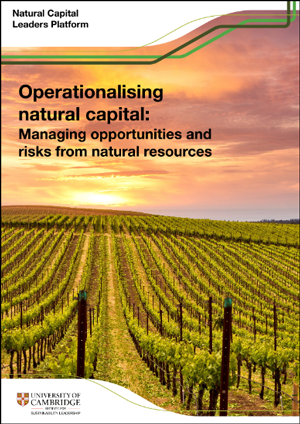July 2016 – With the launch of the Natural Capital Protocol businesses are looking for ways to consider the natural environment in their decision-making.
Context
To date there is no clear mechanism to help businesses incorporate natural resource considerations in their decisions. There is a dearth of simple natural capital indicators that are business relevant and can be linked to commercial metrics. Without this it is difficult for businesses to incorporate assessments of their dependencies and impacts on the natural environment into decision-making processes and to develop clear objectives.
About the report
This report, developed by the Natural Capital Impact Group, explores how businesses are looking for ways to incorporate natural resource concerns in their decision-making. It is intended to provide an overview for sustainability leaders and managers of the state of play of where natural capital is already being included in business decision-making and where there are still barriers to its incorporation.
The ambition
The Natural Capital Leaders Platform members worked with CISL to establish the commercial decisions that are already being impacted by natural resource challenges in their organisations. Rather than taking a narrow perspective to mitigate operational or reputational risk the businesses agreed that they are pursuing longer-term company strategies by recognising natural capital as a financial opportunity; over 50 per cent of the businesses are realising this through their strategic investments. However, it was clear that the commercial impacts resulting from investments in the natural environment are not being articulated through quantifiable metrics. This makes it difficult to communicate successes and future risks across different business departments. Overcoming this challenge is particularly pertinent as corporate functions and senior leadership teams are becoming more engaged around discussions on natural resources.
The Platform identified the opportunity to develop a set of metrics that would link commercial impacts to impacts on the natural environment. This could include indicators for impacts on soil, water, biodiversity and carbon which could be used to communicate the commercial impacts and dependencies on natural resources for business. Such metrics can help further internal buy-in and enable the development of a strong business case for future investments in the natural environment.
Long-term vision
The Natural Capital Leaders Platform members identified a gap in the availability of scalable environmental indicators that link to commercial metrics. The following key themes emerged:
-
Almost all companies interviewed were pursuing longer term company strategies
-
Businesses are concerned with issues associated with the natural environment that impact costs to their business
-
Gaps were identified with regard to current environmental indicators available, such as, soil, water availability and quality and biodiversity and their use in commercial metrics
Making the important links between commercial drivers and environmental performance, by using simple indicators, can enable businesses to make a step change to consider the natural environment in their decision-making.
Citing this report
Please refer to this report as University of Cambridge Institute for Sustainability Leadership (CISL). (2016, July). Operationalising natural capital: Managing opportunities and risks from natural resources. Cambridge, UK: Cambridge Institute for Sustainability Leadership.




